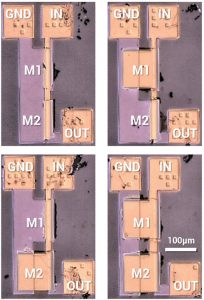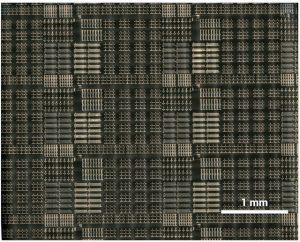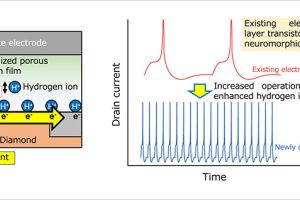
Source-gated transistors – SGTs – are uni-polar – they only need n or p-type semiconductor, not both.
The research team built two two-transistor building blocks:
- A polysilicon gain block with the highest gain ever recorded for similar technology – 49dB (~290x)
- A current mirror with process-robust tunable temperature coefficient
To match the gain of the two-transistor amplifier using standard thin-film transistors (TFTs), according to Surrey semiconductor scientist Radu Sporea, would need a string of cascaded stages. “You can a cascade to get gain, but there is a chance of oscillation unless you compensate. A one-stage amplifier can never oscillate,” he told Electronics Weekly.
A down-side of SGTs is the large temperature coefficient of drain current, inherent in the design because the gate and source must overlap for SG transistors to work – in other transistor types this overlap is minimised by design. The current mirror makes use of the unavoidable temperature coefficient.
“Not all thin-film transistors have high temperature coefficients,” said Sporea. “Source-gated transistors do, and usually that’s a negative, but we’re exploiting the variation of temperature dependence with geometry to create useful functionality with a minimum number of components.”
 “If you design two transistors to have different source-gate overlaps,” he continued, “you get two different temperature coefficients.”
“If you design two transistors to have different source-gate overlaps,” he continued, “you get two different temperature coefficients.”
If these two different transistors are made into a current mirror then, given a fixed input current, “you can play around with the slope of the temperature coefficient of the output current”, said Sporea. “You can have zero temperature coefficient, you can tune the transistors to have a positive temperature coefficient – for a temperature sensor, for example – or you can arrange to have a negative temperature coefficient and use it to regulate temperature in a negative feedback loop – for example you could slow an oscillator if something was over-heating – all in an extremely simple circuit.”
Whilst that are affected by temperature, SGTs are relatively immune from performance variation due to changes in semiconductor performance or transistor geometry. “It is to to do with the way the device works, it is inherent,” said Sporea.
As such, circuits tend to work predictably in the face of process variation – yield is high. “Our design offers a much simpler build process than regular thin-film transistors,” he said. “Source-gated transistor circuits may also be cheaper to manufacture on a large scale because their simplicity means there is less waste in the form of rejected components.”
Are there any disadvantages to SGTs?
These particular SGTs are never going to beat any speed records, said Sporea, the top-end for operation is around 10kHz. “If they are designed for speed, they can go a lot faster. They won’t go as fast as conventional transistors of identical dimensions because it’s a zero-sum game – we gain gain and geometrical tolerance, at the expense of switching speed.”
The work is described in ‘Compact source-gated transistor analog circuits for ubiquitous sensors‘, published by the IEEE and available in full without payment.
 Electronics Weekly Electronics Design & Components Tech News
Electronics Weekly Electronics Design & Components Tech News



